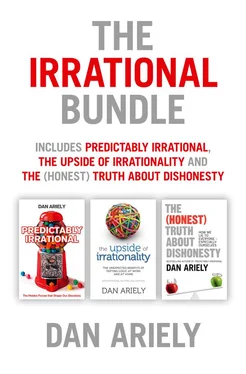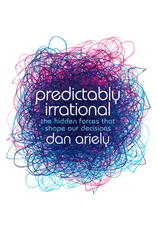Dan Ariely - The Irrational Bundle
Здесь есть возможность читать онлайн «Dan Ariely - The Irrational Bundle» — ознакомительный отрывок электронной книги совершенно бесплатно, а после прочтения отрывка купить полную версию. В некоторых случаях можно слушать аудио, скачать через торрент в формате fb2 и присутствует краткое содержание. Жанр: unrecognised, на английском языке. Описание произведения, (предисловие) а так же отзывы посетителей доступны на портале библиотеки ЛибКат.
- Название:The Irrational Bundle
- Автор:
- Жанр:
- Год:неизвестен
- ISBN:нет данных
- Рейтинг книги:3 / 5. Голосов: 1
-
Избранное:Добавить в избранное
- Отзывы:
-
Ваша оценка:
- 60
- 1
- 2
- 3
- 4
- 5
The Irrational Bundle: краткое содержание, описание и аннотация
Предлагаем к чтению аннотацию, описание, краткое содержание или предисловие (зависит от того, что написал сам автор книги «The Irrational Bundle»). Если вы не нашли необходимую информацию о книге — напишите в комментариях, мы постараемся отыскать её.
The Irrational Bundle — читать онлайн ознакомительный отрывок
Ниже представлен текст книги, разбитый по страницам. Система сохранения места последней прочитанной страницы, позволяет с удобством читать онлайн бесплатно книгу «The Irrational Bundle», без необходимости каждый раз заново искать на чём Вы остановились. Поставьте закладку, и сможете в любой момент перейти на страницу, на которой закончили чтение.
Интервал:
Закладка:
What were the results? In line with the Coke and Pepsi “challenges,” it turned out that the brain activation of the participants was different depending on whether the name of the drink was revealed or not. This is what happened: Whenever a person received a squirt of Coke or Pepsi, the center of the brain associated with strong feelings of emotional connection—called the ventromedial prefrontal cortex, VMPFC—was stimulated. But when the participants knew they were going to get a squirt of Coke, something additional happened. This time, the frontal area of the brain—the dorsolateral aspect of the prefrontal cortex, DLPFC, an area involved in higher human brain functions like working memory, associations, and higher-order cognitions and ideas—was also activated. It happened with Pepsi—but even more so with Coke (and, naturally, the response was stronger in people who had a stronger preference for Coke).
The reaction of the brain to the basic hedonic value of the drinks (essentially sugar) turned out to be similar for the two drinks. But the advantage of Coke over Pepsi was due to Cokes’s brand—which activated the higher-order brain mechanisms. These associations, then, and not the chemical properties of the drink, gave Coke an advantage in the marketplace.
It is also interesting to consider the ways in which the frontal part of the brain is connected to the pleasure center. There is a dopamine link by which the front part of the brain projects and activates the pleasure centers. This is probably why Coke was liked more when the brand was known—the associations were more powerful, allowing the part of the brain that represents these associations to enhance activity in the brain’s pleasure center. This should be good news to any ad agency, of course, because it means that the bright red can, swirling script, and the myriad messages that have come down to consumers over the years (such as “Things go better with . . .”) are as much responsible for our love of Coke as the brown bubbly stuff itself.
EXPECTATIONS ALSO SHAPE stereotypes. A stereotype, after all, is a way of categorizing information, in the hope of predicting experiences. The brain cannot start from scratch at every new situation. It must build on what it has seen before. For that reason, stereotypes are not intrinsically malevolent. They provide shortcuts in our never-ending attempt to make sense of complicated surroundings. This is why we have the expectation that an elderly person will need help using a computer or that a student at Harvard will be intelligent. * Конец ознакомительного фрагмента. Текст предоставлен ООО «ЛитРес». Прочитайте эту книгу целиком, купив полную легальную версию на ЛитРес. Безопасно оплатить книгу можно банковской картой Visa, MasterCard, Maestro, со счета мобильного телефона, с платежного терминала, в салоне МТС или Связной, через PayPal, WebMoney, Яндекс.Деньги, QIWI Кошелек, бонусными картами или другим удобным Вам способом.
But because a stereotype provides us with specific expectations about members of a group, it can also unfavorably influence both our perceptions and our behavior.
Research on stereotypes shows not only that we react differently when we have a stereotype of a certain group of people, but also that stereotyped people themselves react differently when they are aware of the label that they are forced to wear (in psychological parlance, they are “primed” with this label). One stereotype of Asian-Americans, for instance, is that they are especially gifted in mathematics and science. A common stereotype of females is that they are weak in mathematics. This means that Asian-American women could be influenced by both notions.
In fact, they are. In a remarkable experiment, Margaret Shin, Todd Pittinsky, and Nalini Ambady asked Asian-American women to take an objective math exam. But first they divided the women into two groups. The women in one group were asked questions related to their gender. For example, they were asked about their opinions and preferences regarding coed dorms, thereby priming their thoughts for gender-related issues. The women in the second group were asked questions related to their race. These questions referred to the languages they knew, the languages they spoke at home, and their family’s history in the United States, thereby priming the women’s thoughts for race-related issues.
The performance of the two groups differed in a way that matched the stereotypes of both women and Asian-Americans. Those who had been reminded that they were women performed worse than those who had been reminded that they were Asian-American. These results show that even our own behavior can be influenced by our stereotypes, and that activation of stereotypes can depend on our current state of mind and how we view ourselves at the moment.
Perhaps even more astoundingly, stereotypes can also affect the behavior of people who are not even part of a stereotyped group. In one notable study, John Bargh, Mark Chen, and Lara Burrows had participants complete a scrambled-sentence task, rearranging the order of words to form sentences (we discussed this type of task in Chapter 4). For some of the participants, the task was based on words such as aggressive, rude, annoying, and intrude. For others, the task was based on words such as honor, considerate, polite, and sensitive. The goal of these two lists was to prime the participants to think about politeness or rudeness as a result of constructing sentences from these words (this is a very common technique in social psychology, and it works amazingly well).
After the participants completed the scrambled-sentence task, they went to another laboratory to participate in what was purportedly a second task. When they arrived at the second laboratory, they found the experimenter apparently in the midst of trying to explain the task to an uncomprehending participant who was just not getting it (this supposed participant was in fact not a real participant but a confederate working for the experimenter). How long do you think it took the real participants to interrupt the conversation and ask what they should do next?
The amount of waiting depended on what type of words had been involved in the scrambled-sentence task. Those who had worked with the set of polite words patiently waited for about 9.3 minutes before they interrupted, whereas those who had worked with the set of rude words waited only about 5.5 minutes before interrupting.
A second experiment tested the same general idea by priming the concept of the elderly, using words such as Florida, bingo, and ancient. After the participants in this experiment completed the scrambled-sentence task, they left the room, thinking that they had finished the experiment—but in fact the crux of the study was just beginning. What truly interested the researchers was how long it would take the participants to walk down the hallway as they left the building. Sure enough, the participants in the experimental group were affected by the “elderly” words: their walking speed was considerably slower than that of a control group who had not been primed. And remember, the primed participants were not themselves elderly people being reminded of their frailty—they were undergraduate students at NYU.
ALL THESE EXPERIMENTS teach us that expectations are more than the mere anticipation of a boost from a fizzy Coke. Expectations enable us to make sense of a conversation in a noisy room, despite the loss of a word here and there, and likewise, to be able to read text messages on our cell phones, despite the fact that some of the words are scrambled. And although expectations can make us look foolish from time to time, they are also very powerful and useful.
Читать дальшеИнтервал:
Закладка:
Похожие книги на «The Irrational Bundle»
Представляем Вашему вниманию похожие книги на «The Irrational Bundle» списком для выбора. Мы отобрали схожую по названию и смыслу литературу в надежде предоставить читателям больше вариантов отыскать новые, интересные, ещё непрочитанные произведения.
Обсуждение, отзывы о книге «The Irrational Bundle» и просто собственные мнения читателей. Оставьте ваши комментарии, напишите, что Вы думаете о произведении, его смысле или главных героях. Укажите что конкретно понравилось, а что нет, и почему Вы так считаете.












